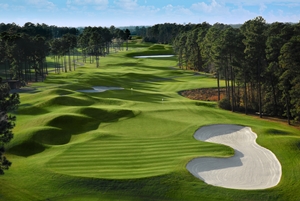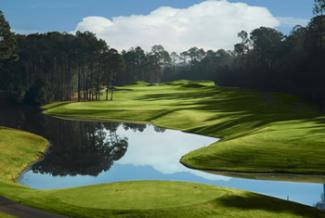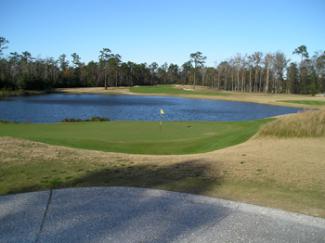Featured Golf News
Trio of Courses Serve as Great Intro to Myrtle Beach
Anyone interested in a seemingly unlimited supply of quality golf must heed the siren's call to Myrtle Beach, S.C. The destination boasts more than 100 courses in its "Grand Strand" area, which extends north from Georgetown, through Myrtle Beach, and into North Carolina's southern coast. Here golf is the main draw - or slice, as it were.

Shared 6th & 17th Green at Wild Wing Plantation
This golfers' paradise boasts layouts designed by many of the world's top architects. Coupled with its location on the Atlantic coast and plenty of amenities and attractions, players can have almost as much fun off the course as on.
Myrtle Beach courses offer more varied choices than a golfer could imagine. With so many places to play and only so many hours in a day, our first trip to the area earlier this spring was designed to tee it up on specific tracks for specific reasons. Because the menu can be a bit daunting, we looked for venues that could act as a solid indoctrination to what the area has to offer. We came up with five wonderful examples of the layouts, which require a high skill level but are also fun.
This first feature on Myrtle Beach profiles the Avocet Course at Wild Wing Plantation (a survivor), King's North at Myrtle Beach National (reborn better than ever) and the Love Course at Barefoot Resort (designed to snatch headlines): three courses built in different decades and with varying styles. All are a good illustration of where Myrtle Beach has been, where it's at right now and where it's going.

Avocet Course at Wild Wing Plantation
Avocet is Wild Wing's Survivor
With the need for space in Myrtle Beach for residential growth at a premium in December of 2005, Wild Wing Plantation was sold to a group of developers that included some of the owners of Arrowhead Country Club. The new proprietors closed three of the four courses; gone are the Falcon and Wood Stork courses and the Hummingbird was reopened as a links-style, nine-hole track.
That left Avocet course to carry the Wild Wing banner, and it is more than up to the challenge. This Larry Nelson signature course was actually designed by Jeffrey D. Brauer and features multiple tees (some of which are elevated), wide landing areas, contoured fairways (including the occasional double-fairway), grass bunkers, a moderate amount of sand traps, strategically placed water, and fast, elevated putting surfaces. There's even a double-green serving two holes.
Opened in 1993, the par-72 and stretching 7,127-yards from the tips, where it carries a 74.6 rating and 133 slope, Avocet is a course where each hole is memorable for its enjoyment, aesthetics and playability. It was the third course built at Wild Wing, but it has always been considered the property's best and most unique track. The opening hole, a 402-yard par-4, is defined by grass depressions in lieu of sand bunkers around the green. The par-4 sixth features a three-tiered, double-green shared with the par-3 17th. The 362-yard ninth - considered by many to be the signature hole - has a double-fairway split by a line of grass and sand-filled pot bunkers.
The 308-yard par-4 14th was, in 1997, named as one of "The Best 18 Holes You Can Play." The reachable two-shotter has most golfers thinking about birdie or better, but that means ripping your tee shot over water and a series of pot bunkers to a green bisected by a large ridge running front to back.
Most players like expansive fairways and big greens, and Avocet has plenty of these. While Avocet may not be traditional, Brauer gave a nod to the game's architectural origins with a non-conventional design approach.
Design aficionados will relate to the large depression on the front-left part of the green on the aforementioned ninth, a re-creation of the "Valley of Sin" on the 18th green at St. Andrew's Old Course. The 227-yard par-3 12th hole is a mirror image of Scotland's famous and often replicated Redan hole, only longer and with sharper teeth.
The 453-yard par-4 18th, hailed as "Cape" on the course guide, was patterned after the famed C.B. Macdonald cape hole at the Mid-Ocean Club in Bermuda, sweeping leftward around water down the entire left side. It tempts players to cut off as much as they dare to shorten the most difficult approach shot on the course.
In 1994 Golf Digest named the Avocet as one of "The Top 10 Best New Resort Courses in America," and the South Carolina Golf Course Owners Association named the track South Carolina's Golf Course of the Year for 2002-03.
Nelson and Brauer's goal was to create a playable and enjoyable test that would garner repeat play. Its scenic surroundings coupled with a variety of interesting holes and the service-consciousness of Wild Wing, Avocet is a track that produces great shots and even better memories.
Operated by the Myrtle Beach National Company since early 2010, Avocet provides the full Myrtle Beach experience. For more information, visit www.wildwing.com.

12th Green at King's North
King's North - Tricky but Solid
In the years after Wild Wing was built and was still flourishing with its now-shuttered trio of sister courses, the three tracks at Myrtle Beach National (Southcreek, West and North) were also doing banner business.
Myrtle Beach National was fashioned by the Arnold Palmer Group and opened in 1974. But by the mid-90s North had fallen out of favor with members and tourists and needed sprucing up. After one of the most extravagant facelifts in Myrtle Beach golf history, the course reopened in 1996 as King's North after Palmer and his design associate Ed Seay left no stone upturned to make the course what it is today.
The team rebuilt the tees, greens, bunkers and lakes at the venerable layout, and they switched the nines; the current 18th hole is now more dramatic with its view of the clubhouse. The sizes and undulations of the greens were increased and bunkers, mounds and bulkheads were added, resulting in an entirely different track.
King's North's routing brings lakes, ponds and marshes into play on 16 of its holes. The land was heavily reshaped, so the course now has plenty of roll and movement. Many trees were cleared, mostly for circulation purposes, and the course is now open, with wide fairways and no housing beside them.
Palmer and Seay's work was widely recognized; King's North garnered mention among the roster of "America's Best New Courses" when it reopened in 1996.
The layout is noted for its gimmicky holes. First there is the 365-yard par-4 third, with a putting surface on a cape fronted by a South Carolina-shaped bunker. Then there's the famed 568-yard par-5 sixth - nicknamed "The Gambler" - that tempts golfers with a shortcut to the green via an island fairway. The hole was christened by singer Kenny Rogers himself in 1996; his spike marks are cast in concrete near the tee.
And don't forget King's North's locally celebrated closer, which from the tips tops out at 464 yards. The left side has more than 40 bunkers while its right flank is bordered by a lake.
The collection of par-3s here is another strong point. Each plays to a green guarded in front by water, none more so than the 140-yard 12th, which plays entirely over water to an island green; there's no bailout right, while two sand bunkers lurk along the left.
Currently ranked No. 29 in Golf Digest's Best Golf Courses in South Carolina, King's North at Myrtle Beach National was named "South Carolina's Course of the Year for 1996" and, in 1997, Golf Digest ranked it among the "Top 10 New Upscale Public Courses in America."
King's North made its way onto Golf Digest's list of "America's 100 Greatest Public Courses - 2004," and from 2000-2004 "Golf for Women" ranked it among its "Top 100 Courses in America."
Despite all the attention-grabbing holes, King's North is known first and foremost for its playability. At a par of 72 and playing 7,017 yards from its back set of six tees (where it's rated 74.2 with a 137 slope), the layout is suitable to a variety of different skills levels. It can play as hard or as easy as you want. For further details, visit www.mbn.com/courses/kings-north.

The Ruins at Barefoot Love
Love Takes no Backseat at Barefoot
The Barefoot Resort in North Myrtle Beach is renowned for its foursome of famous courses, tracks fashioned by Pete Dye, Greg Norman, Tom Fazio and Davis Love III. And while many might think that Love is out of this league of architectural icons, the course he routed and built may be the best of the bunch.
A Carolina native and the 1997 PGA champion, Love used all of his experiences as a background and then embraced a tradition of Lowcountry character in the design of this course. The result is a traditional track that incorporates the re-created ruins of a 17th Century plantation, similar to those found in Scotland and Ireland, generous landing areas and demanding greens complexes. Extending 7,047 yards from the tips, the par-72 venue is rated 75.1 and sloped at 139.
To their credit, Love and his brother-design partner Mark Love didn't attempt to come up with some tricked-up track that might impress his fellow architects at Barefoot Resort. Instead, the Loves give golfers the freedom to grip it and rip it; indeed, the driver is your best friend at this layout.
Barefoot Love has plenty of risk-reward options as 13 of the 18 holes give you the option of taking a more direct, danger-filled path to the green or to play it scorecard safe. For example, the 294-yard, par-4 fourth can be driven but the fairway extends up a ridge to the base of the re-created ruins of an old Plantation house where slaves were kept. The ruins are completely fake - they date back only to 2000, but their broken, standing brick walls and stone columns, some completely covered in ivy, can be a real pain if your approach is a little long.
This course is replete with nice touches: the sixth, a 403-yard, par-4 curves around waterway and heavy bush area, has low-lying brick walls right below the green. The wall forces a slightest elevation on your iron approach and yet creates a lot of interest.
The difficulty in the Love Course comes in the putting surfaces, which are known for their crowned configurations. "The greens are very much in the Donald Ross style," Love said. "And, as with most of Ross's courses, short is definitely better than long." Adding to the discomfort, most sides are shaved to draw shots into collection areas.
The best of the fine set of par-3s is the 235-yard ninth, which features a forced carry over a wetland. The best hole on the course is arguably the 552-yard eighth, with a fairway marked by a bunker some 275 yards out by the left center of the fairway. A good safe drive to the right of the bunker leaves a long approach over an environmental area to an elevated, well-trapped green. It's a marvelously designed hole with strong visuals.
Some of the trouble on the Love course is more perceived than actual. Bunkers appear to sit near greens but don't, and plateaus false-front some putting surfaces. Love puts bunkers in your face on the 450-yard par seventh. And beware of the waste bunkers and the tricky, left-sloping fairway on No. 14.

18th Green at Barefoot Love
The track is not overly long by today's standards, but there are still some monsters. No. 5, a 463-yard par-4, is a devilish dogleg-right that mandates a left-to-right drive. Don't over-cut your drive as a lake is waiting. More water and fairway bunkers make reaching the green in two quite difficult. "Remember that the fairway is wider than it looks, and play your approach to the front half of the green for the best chance to get down in two."
Barefoot Resort's Love Course's ultimate hole, a 596-yard par-5, features a fairway that narrows to a slit and an intimidating approach to a green guarded left by water.
Barefoot-Love is ranked No. 86 on Golf Magazine's "Top 100 Courses You Can Play" and No. 3 in South Carolina on Golfweek's "Best Courses You Can Play."
Competing with other architects in the Barefoot Resort project, Love was determined to build a course that was unique, visually striking and fun. The PGA Tour veteran was good on all accounts as this is one of Myrtle Beach's most popular courses since it opened in 2000.
You might play Barefoot Love because of the long, wide fairways; striking and imaginative visuals; or the challenge of its greens and surrounds. But what you'll remember the most are the shot choices. For more information, visit www.barefootgolf.com.
Planning a Trip to Myrtle Beach
The best way to tee it up for a Myrtle Beach stay-and-play outing is by using the comprehensive resources at Myrtle Beach Golf Holiday (www.GolfHoliday.com). The nonprofit trade association consists of 102 courses, 76 golf-package providers and five golf schools. Using the site makes it as easy as possible for golfers to reserve accommodations and tee times in accordance with their preferred level of luxury and economy.
Steve Habel is one of Cybergolf's national correspondents, contributing news stories, features, equipment and book reviews and personality profiles from his base in Central Texas. He is also the managing editor for Texas CEO Magazine and works as a contributing editor for Horns Illustrated magazine, a publication focusing on University of Texas sports. He also writes a blog (www.shotoverthegreen.blogspot.com), which features news on golf and the Longhorns, and another (www.checkinginandplayingthrough.blogspot.com) on his many travels, which took him across the nation and to 105 different golf course in 2009. Habel is a member of the Golf Writers Association of America and the Texas Golf Writers Association.
Story Options
 |
Print this Story |
